System Analysis and Design of My Health Records Project Report
VerifiedAdded on 2023/06/13
|12
|1882
|361
Report
AI Summary
This report provides a comprehensive analysis and design of the 'My Health Records' system. It includes a stakeholder analysis, mapping internal and external stakeholders like project team members, technicians, medical staff, investors, and government, detailing their interests and roles. A questionnaire targeted at health board members, investors, and hospital owners explores user interface expectations, functionality, security, integrity, and application requirements. The report further presents a use case diagram illustrating system functionalities and provides a detailed description of the 'Fix Appointment' use case, outlining the scenario, triggering event, actors (nurses), preconditions, post conditions, and flow of activities. The analysis aims to align system development with stakeholder expectations and optimize healthcare operations.

Running head: SYSTEM ANALYSIS AND DESIGN
System Analysis and Design
“My Health Records”
Name of the Student:
Student ID:
Name of the University:
Author’s note:
System Analysis and Design
“My Health Records”
Name of the Student:
Student ID:
Name of the University:
Author’s note:
Paraphrase This Document
Need a fresh take? Get an instant paraphrase of this document with our AI Paraphraser
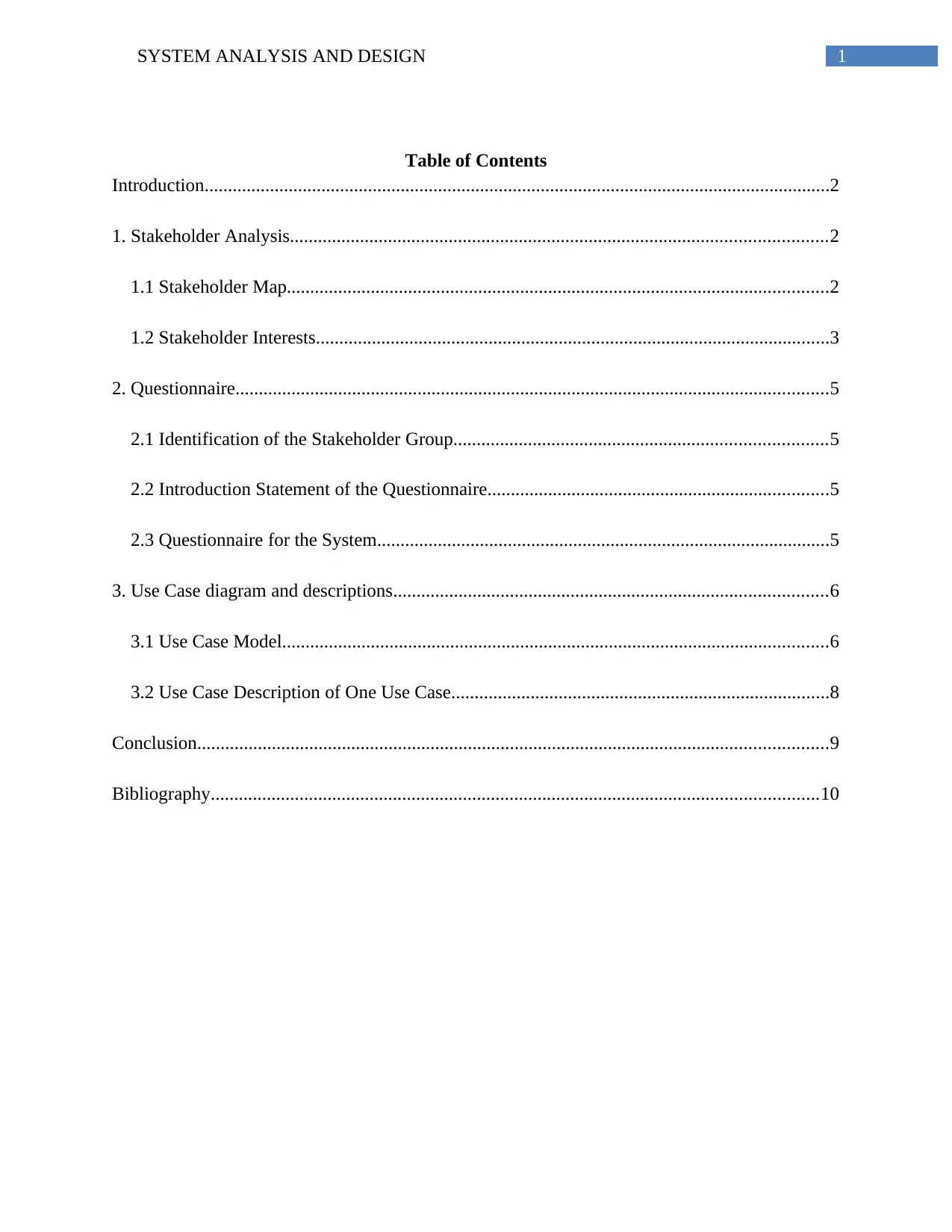
1SYSTEM ANALYSIS AND DESIGN
Table of Contents
Introduction......................................................................................................................................2
1. Stakeholder Analysis...................................................................................................................2
1.1 Stakeholder Map....................................................................................................................2
1.2 Stakeholder Interests..............................................................................................................3
2. Questionnaire...............................................................................................................................5
2.1 Identification of the Stakeholder Group................................................................................5
2.2 Introduction Statement of the Questionnaire.........................................................................5
2.3 Questionnaire for the System.................................................................................................5
3. Use Case diagram and descriptions.............................................................................................6
3.1 Use Case Model.....................................................................................................................6
3.2 Use Case Description of One Use Case.................................................................................8
Conclusion.......................................................................................................................................9
Bibliography..................................................................................................................................10
Table of Contents
Introduction......................................................................................................................................2
1. Stakeholder Analysis...................................................................................................................2
1.1 Stakeholder Map....................................................................................................................2
1.2 Stakeholder Interests..............................................................................................................3
2. Questionnaire...............................................................................................................................5
2.1 Identification of the Stakeholder Group................................................................................5
2.2 Introduction Statement of the Questionnaire.........................................................................5
2.3 Questionnaire for the System.................................................................................................5
3. Use Case diagram and descriptions.............................................................................................6
3.1 Use Case Model.....................................................................................................................6
3.2 Use Case Description of One Use Case.................................................................................8
Conclusion.......................................................................................................................................9
Bibliography..................................................................................................................................10
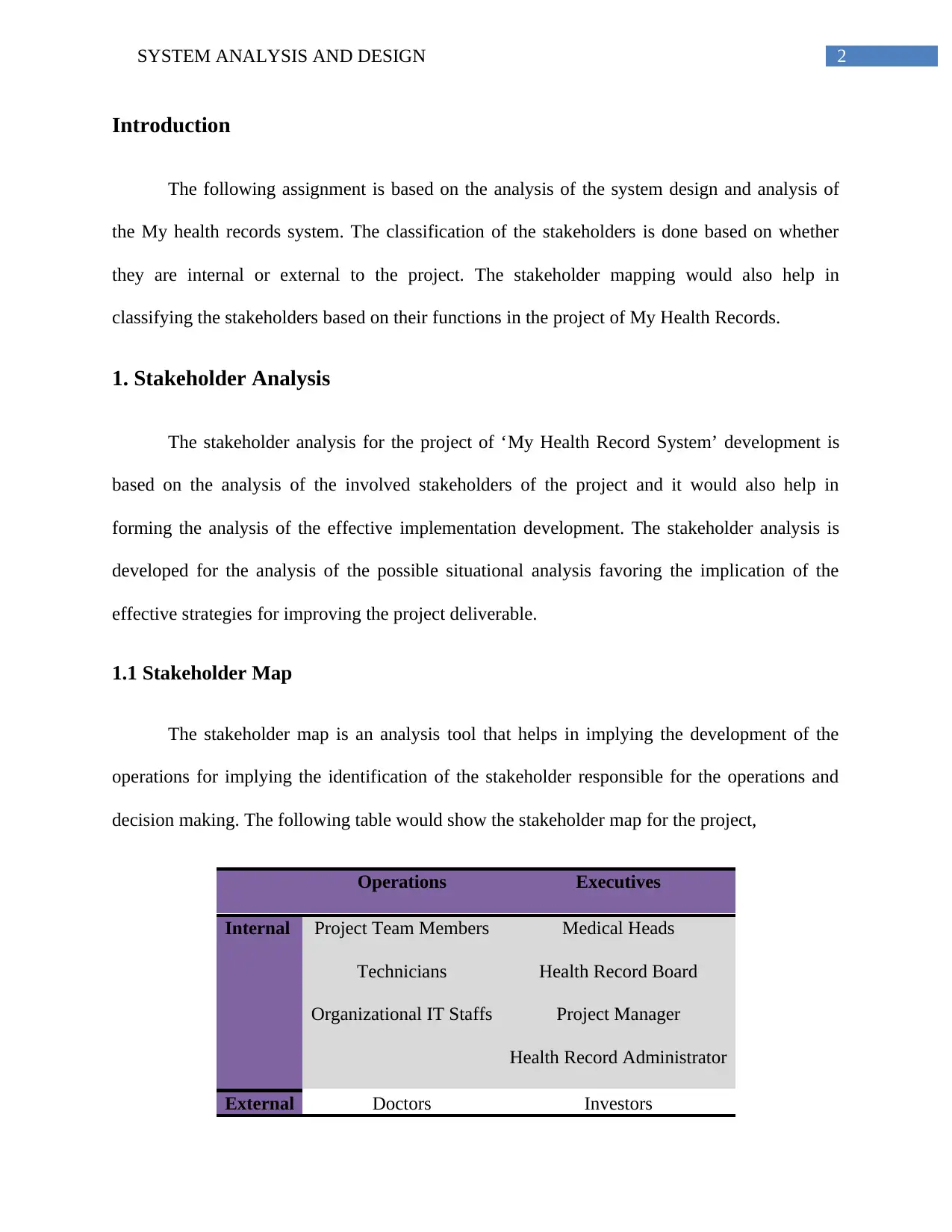
2SYSTEM ANALYSIS AND DESIGN
Introduction
The following assignment is based on the analysis of the system design and analysis of
the My health records system. The classification of the stakeholders is done based on whether
they are internal or external to the project. The stakeholder mapping would also help in
classifying the stakeholders based on their functions in the project of My Health Records.
1. Stakeholder Analysis
The stakeholder analysis for the project of ‘My Health Record System’ development is
based on the analysis of the involved stakeholders of the project and it would also help in
forming the analysis of the effective implementation development. The stakeholder analysis is
developed for the analysis of the possible situational analysis favoring the implication of the
effective strategies for improving the project deliverable.
1.1 Stakeholder Map
The stakeholder map is an analysis tool that helps in implying the development of the
operations for implying the identification of the stakeholder responsible for the operations and
decision making. The following table would show the stakeholder map for the project,
Operations Executives
Internal Project Team Members
Technicians
Organizational IT Staffs
Medical Heads
Health Record Board
Project Manager
Health Record Administrator
External Doctors Investors
Introduction
The following assignment is based on the analysis of the system design and analysis of
the My health records system. The classification of the stakeholders is done based on whether
they are internal or external to the project. The stakeholder mapping would also help in
classifying the stakeholders based on their functions in the project of My Health Records.
1. Stakeholder Analysis
The stakeholder analysis for the project of ‘My Health Record System’ development is
based on the analysis of the involved stakeholders of the project and it would also help in
forming the analysis of the effective implementation development. The stakeholder analysis is
developed for the analysis of the possible situational analysis favoring the implication of the
effective strategies for improving the project deliverable.
1.1 Stakeholder Map
The stakeholder map is an analysis tool that helps in implying the development of the
operations for implying the identification of the stakeholder responsible for the operations and
decision making. The following table would show the stakeholder map for the project,
Operations Executives
Internal Project Team Members
Technicians
Organizational IT Staffs
Medical Heads
Health Record Board
Project Manager
Health Record Administrator
External Doctors Investors
⊘ This is a preview!⊘
Do you want full access?
Subscribe today to unlock all pages.

Trusted by 1+ million students worldwide
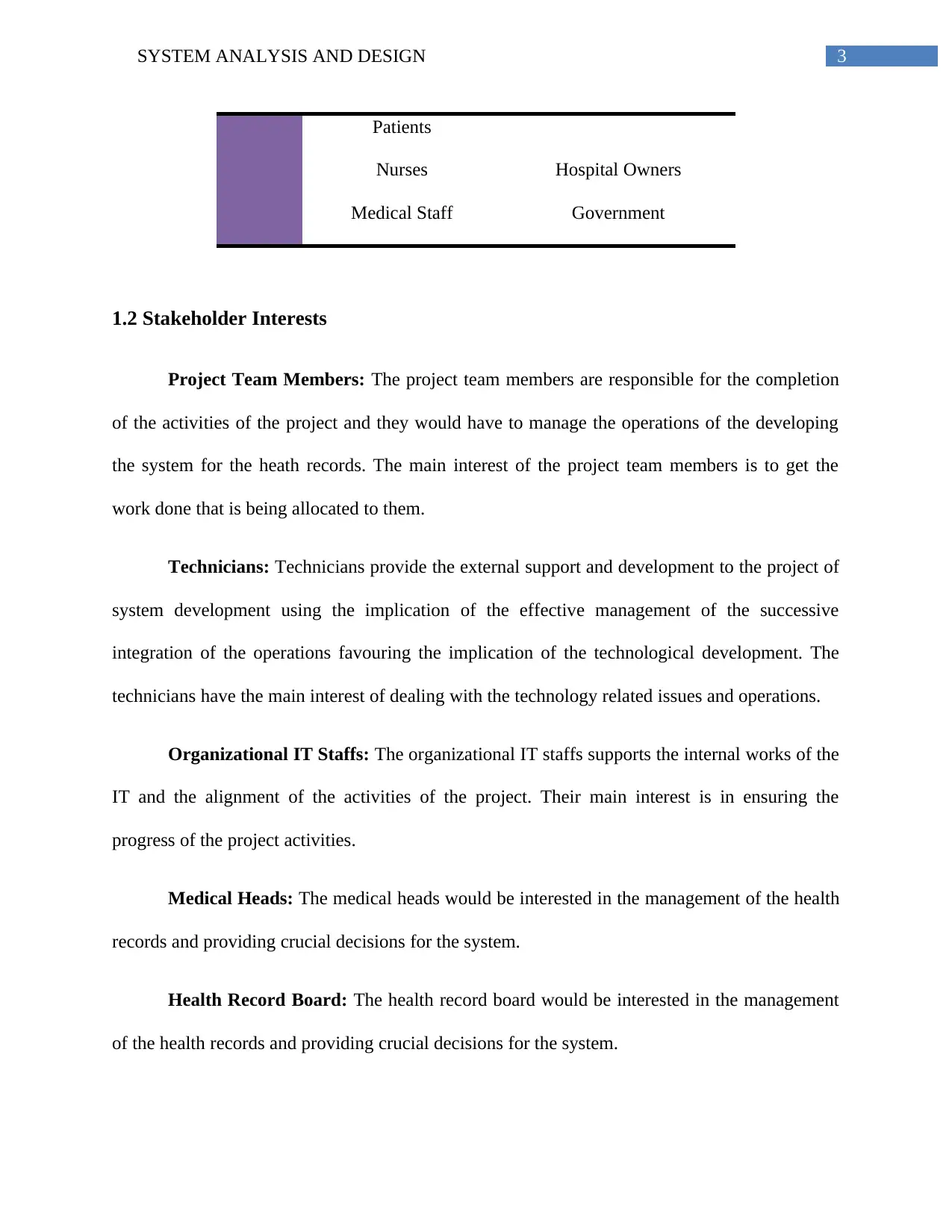
3SYSTEM ANALYSIS AND DESIGN
Patients
Nurses
Medical Staff
Hospital Owners
Government
1.2 Stakeholder Interests
Project Team Members: The project team members are responsible for the completion
of the activities of the project and they would have to manage the operations of the developing
the system for the heath records. The main interest of the project team members is to get the
work done that is being allocated to them.
Technicians: Technicians provide the external support and development to the project of
system development using the implication of the effective management of the successive
integration of the operations favouring the implication of the technological development. The
technicians have the main interest of dealing with the technology related issues and operations.
Organizational IT Staffs: The organizational IT staffs supports the internal works of the
IT and the alignment of the activities of the project. Their main interest is in ensuring the
progress of the project activities.
Medical Heads: The medical heads would be interested in the management of the health
records and providing crucial decisions for the system.
Health Record Board: The health record board would be interested in the management
of the health records and providing crucial decisions for the system.
Patients
Nurses
Medical Staff
Hospital Owners
Government
1.2 Stakeholder Interests
Project Team Members: The project team members are responsible for the completion
of the activities of the project and they would have to manage the operations of the developing
the system for the heath records. The main interest of the project team members is to get the
work done that is being allocated to them.
Technicians: Technicians provide the external support and development to the project of
system development using the implication of the effective management of the successive
integration of the operations favouring the implication of the technological development. The
technicians have the main interest of dealing with the technology related issues and operations.
Organizational IT Staffs: The organizational IT staffs supports the internal works of the
IT and the alignment of the activities of the project. Their main interest is in ensuring the
progress of the project activities.
Medical Heads: The medical heads would be interested in the management of the health
records and providing crucial decisions for the system.
Health Record Board: The health record board would be interested in the management
of the health records and providing crucial decisions for the system.
Paraphrase This Document
Need a fresh take? Get an instant paraphrase of this document with our AI Paraphraser
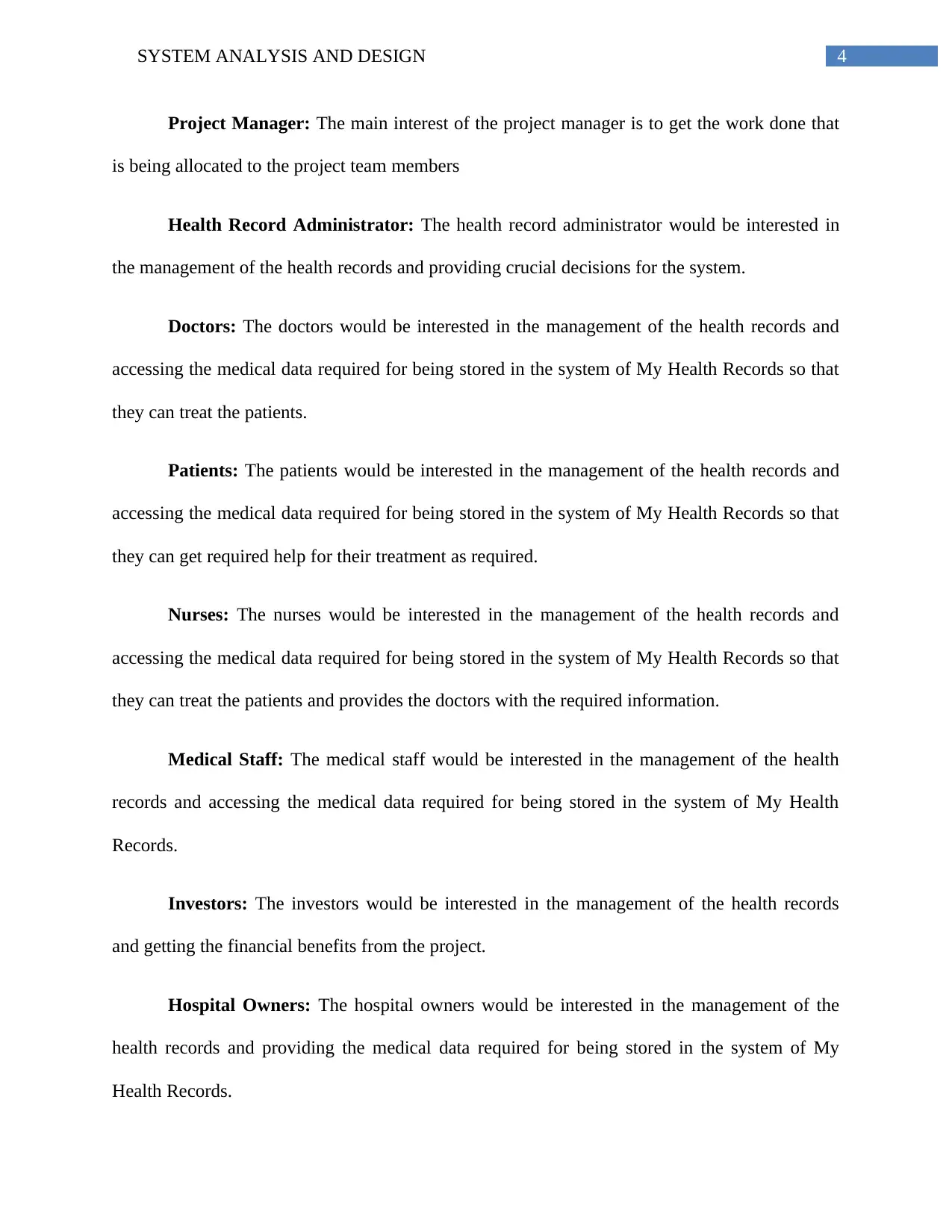
4SYSTEM ANALYSIS AND DESIGN
Project Manager: The main interest of the project manager is to get the work done that
is being allocated to the project team members
Health Record Administrator: The health record administrator would be interested in
the management of the health records and providing crucial decisions for the system.
Doctors: The doctors would be interested in the management of the health records and
accessing the medical data required for being stored in the system of My Health Records so that
they can treat the patients.
Patients: The patients would be interested in the management of the health records and
accessing the medical data required for being stored in the system of My Health Records so that
they can get required help for their treatment as required.
Nurses: The nurses would be interested in the management of the health records and
accessing the medical data required for being stored in the system of My Health Records so that
they can treat the patients and provides the doctors with the required information.
Medical Staff: The medical staff would be interested in the management of the health
records and accessing the medical data required for being stored in the system of My Health
Records.
Investors: The investors would be interested in the management of the health records
and getting the financial benefits from the project.
Hospital Owners: The hospital owners would be interested in the management of the
health records and providing the medical data required for being stored in the system of My
Health Records.
Project Manager: The main interest of the project manager is to get the work done that
is being allocated to the project team members
Health Record Administrator: The health record administrator would be interested in
the management of the health records and providing crucial decisions for the system.
Doctors: The doctors would be interested in the management of the health records and
accessing the medical data required for being stored in the system of My Health Records so that
they can treat the patients.
Patients: The patients would be interested in the management of the health records and
accessing the medical data required for being stored in the system of My Health Records so that
they can get required help for their treatment as required.
Nurses: The nurses would be interested in the management of the health records and
accessing the medical data required for being stored in the system of My Health Records so that
they can treat the patients and provides the doctors with the required information.
Medical Staff: The medical staff would be interested in the management of the health
records and accessing the medical data required for being stored in the system of My Health
Records.
Investors: The investors would be interested in the management of the health records
and getting the financial benefits from the project.
Hospital Owners: The hospital owners would be interested in the management of the
health records and providing the medical data required for being stored in the system of My
Health Records.

5SYSTEM ANALYSIS AND DESIGN
Government: The Government would be interested in the management of the health
records and providing approval of the system developed by ensuring that the standards are met.
2. Questionnaire
2.1 Identification of the Stakeholder Group
The questionnaire would be sent to the health board members, investors, and the hospital
owners of the project. They are in charge of the key decision making for the project of My
Health Record System Development.
2.2 Introduction Statement of the Questionnaire
The introduction statement of the questionnaire is given below,
“The following questionnaire consists of a set of 10 open ended questions related to the expected
system’s user interface, functionality, security, integrity, and applications. The completion of the
questionnaire would help us in modifying the application as per your expectations”.
2.3 Questionnaire for the System
Topic Questions Answers
User Interface What are the expected design requirements
of the system to be developed?
How many function tabs do you need in the
system home page?
Functionality What is the expected deliverable for the
data tab classification?
Government: The Government would be interested in the management of the health
records and providing approval of the system developed by ensuring that the standards are met.
2. Questionnaire
2.1 Identification of the Stakeholder Group
The questionnaire would be sent to the health board members, investors, and the hospital
owners of the project. They are in charge of the key decision making for the project of My
Health Record System Development.
2.2 Introduction Statement of the Questionnaire
The introduction statement of the questionnaire is given below,
“The following questionnaire consists of a set of 10 open ended questions related to the expected
system’s user interface, functionality, security, integrity, and applications. The completion of the
questionnaire would help us in modifying the application as per your expectations”.
2.3 Questionnaire for the System
Topic Questions Answers
User Interface What are the expected design requirements
of the system to be developed?
How many function tabs do you need in the
system home page?
Functionality What is the expected deliverable for the
data tab classification?
⊘ This is a preview!⊘
Do you want full access?
Subscribe today to unlock all pages.

Trusted by 1+ million students worldwide
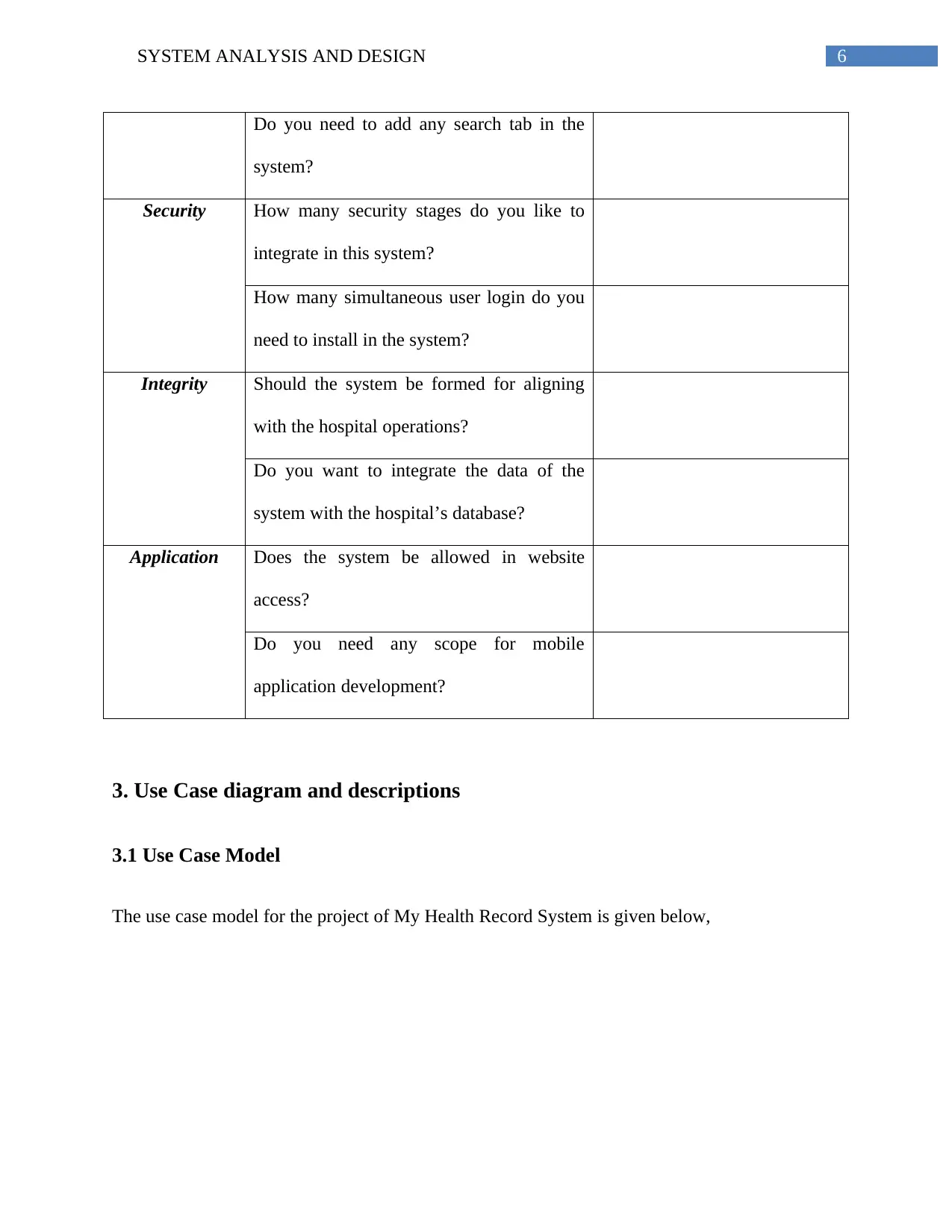
6SYSTEM ANALYSIS AND DESIGN
Do you need to add any search tab in the
system?
Security How many security stages do you like to
integrate in this system?
How many simultaneous user login do you
need to install in the system?
Integrity Should the system be formed for aligning
with the hospital operations?
Do you want to integrate the data of the
system with the hospital’s database?
Application Does the system be allowed in website
access?
Do you need any scope for mobile
application development?
3. Use Case diagram and descriptions
3.1 Use Case Model
The use case model for the project of My Health Record System is given below,
Do you need to add any search tab in the
system?
Security How many security stages do you like to
integrate in this system?
How many simultaneous user login do you
need to install in the system?
Integrity Should the system be formed for aligning
with the hospital operations?
Do you want to integrate the data of the
system with the hospital’s database?
Application Does the system be allowed in website
access?
Do you need any scope for mobile
application development?
3. Use Case diagram and descriptions
3.1 Use Case Model
The use case model for the project of My Health Record System is given below,
Paraphrase This Document
Need a fresh take? Get an instant paraphrase of this document with our AI Paraphraser
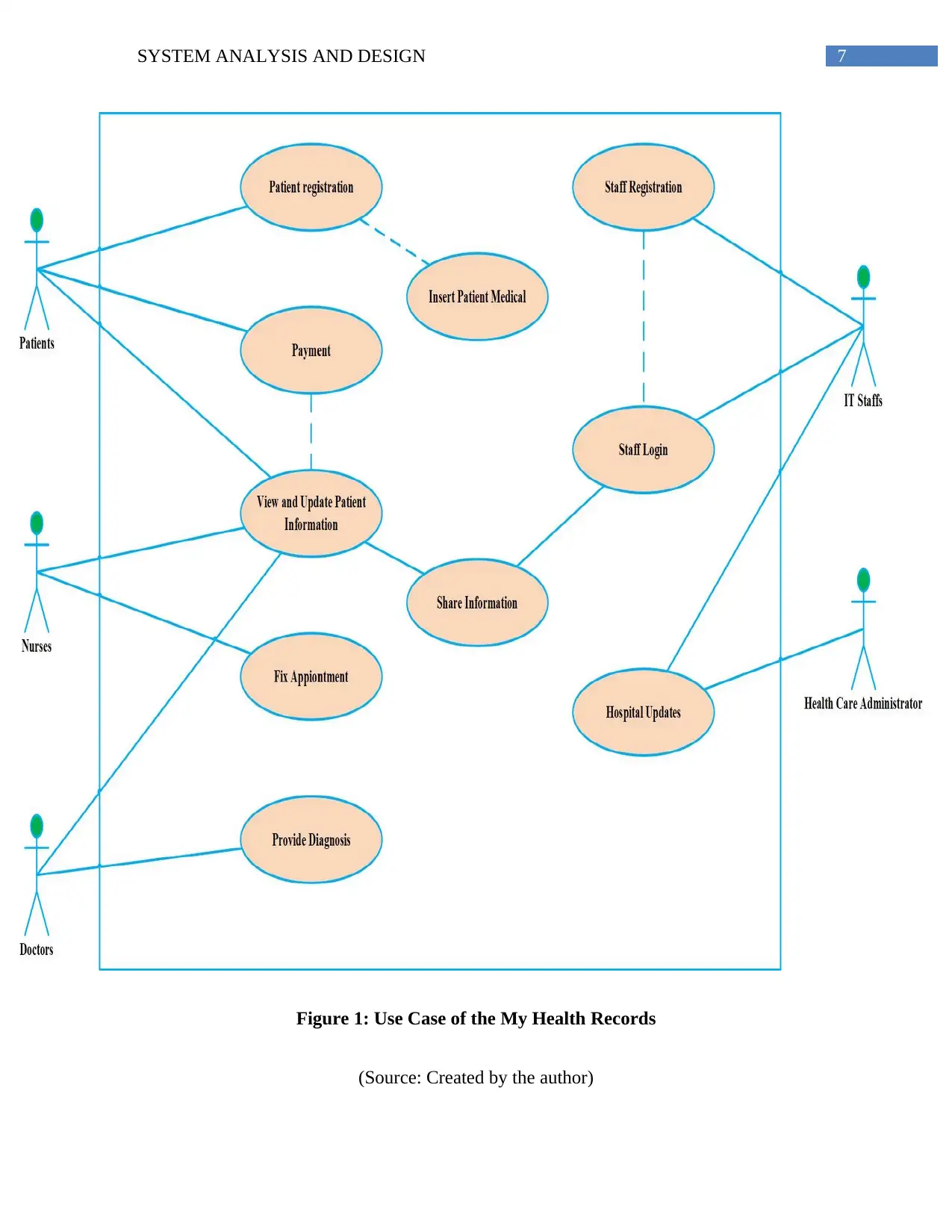
7SYSTEM ANALYSIS AND DESIGN
Figure 1: Use Case of the My Health Records
(Source: Created by the author)
Figure 1: Use Case of the My Health Records
(Source: Created by the author)

8SYSTEM ANALYSIS AND DESIGN
3.2 Use Case Description of One Use Case
The use case description of the fix appointment is given below,
Use Case Name: Fix Appointment
Scenario: The use case of fix appointment is one of the most crucial use case
activities of the system. The nurses are responsible for fixing the
appointment of meeting of the patients and doctors.
Triggering Event: Patients Registering at the My health records, Doctors available for
treating the patients, complete information is provided by the patient
Brief Description: The complete system is developed for easing the treatment of the
patients by the help of the health records kept in the new system of
my health records. The implication of the activities for favoring the
alignment of the operations for fixing the appointment of the patients
with the doctors. The patients would require the treatment from the
specific doctors for their treatment.
Actors: Nurses
Stakeholders: Nurses, Patients, and Doctors
Preconditions: Information related to the patients is studied by the doctor and the
doctor is available for treating the patient
Post conditions: The patients would meet the doctor on the schedule appointment
date and get the required treatment
Flow of Activities: Nurses>Doctor>Nurses>Patients
Exception Conditions: NA
3.2 Use Case Description of One Use Case
The use case description of the fix appointment is given below,
Use Case Name: Fix Appointment
Scenario: The use case of fix appointment is one of the most crucial use case
activities of the system. The nurses are responsible for fixing the
appointment of meeting of the patients and doctors.
Triggering Event: Patients Registering at the My health records, Doctors available for
treating the patients, complete information is provided by the patient
Brief Description: The complete system is developed for easing the treatment of the
patients by the help of the health records kept in the new system of
my health records. The implication of the activities for favoring the
alignment of the operations for fixing the appointment of the patients
with the doctors. The patients would require the treatment from the
specific doctors for their treatment.
Actors: Nurses
Stakeholders: Nurses, Patients, and Doctors
Preconditions: Information related to the patients is studied by the doctor and the
doctor is available for treating the patient
Post conditions: The patients would meet the doctor on the schedule appointment
date and get the required treatment
Flow of Activities: Nurses>Doctor>Nurses>Patients
Exception Conditions: NA
⊘ This is a preview!⊘
Do you want full access?
Subscribe today to unlock all pages.

Trusted by 1+ million students worldwide
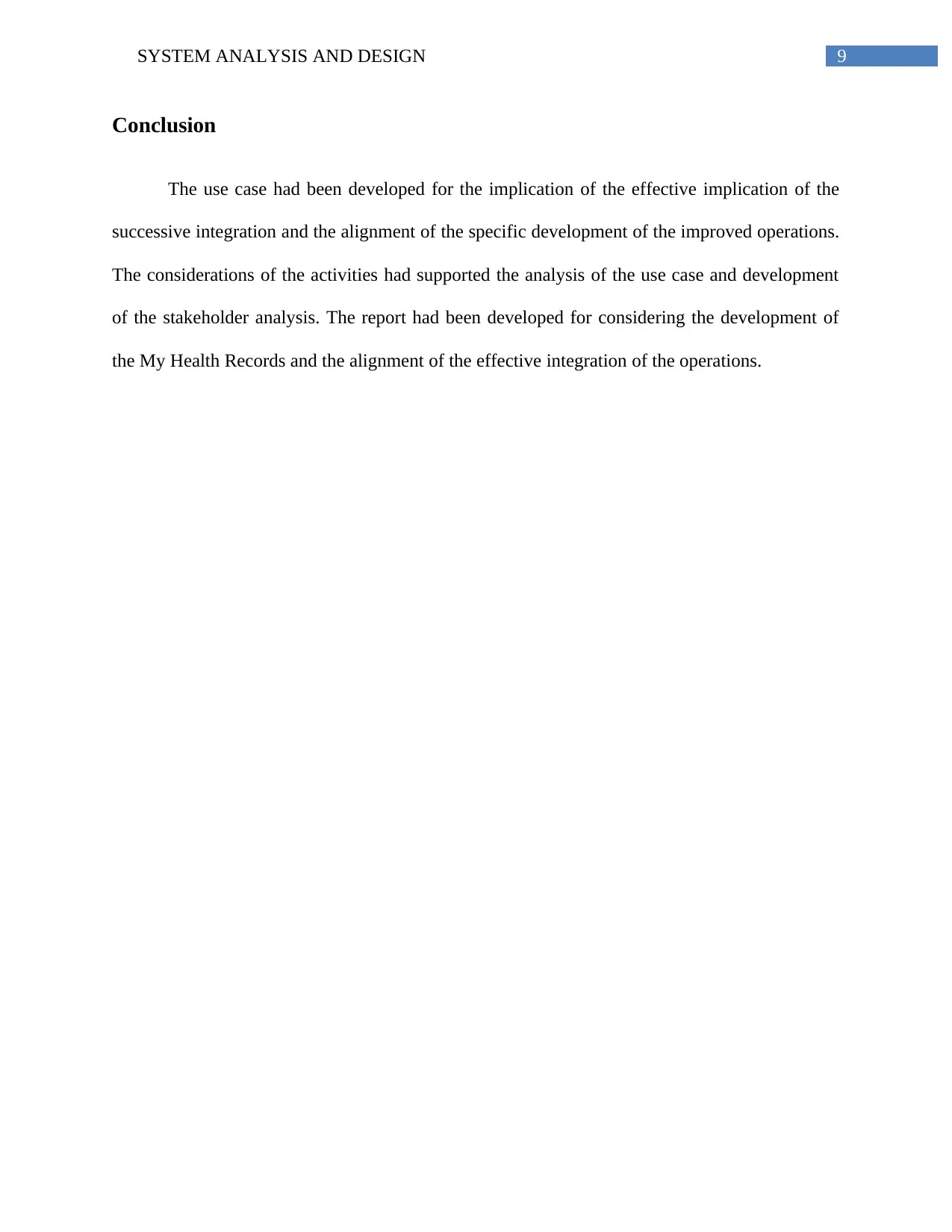
9SYSTEM ANALYSIS AND DESIGN
Conclusion
The use case had been developed for the implication of the effective implication of the
successive integration and the alignment of the specific development of the improved operations.
The considerations of the activities had supported the analysis of the use case and development
of the stakeholder analysis. The report had been developed for considering the development of
the My Health Records and the alignment of the effective integration of the operations.
Conclusion
The use case had been developed for the implication of the effective implication of the
successive integration and the alignment of the specific development of the improved operations.
The considerations of the activities had supported the analysis of the use case and development
of the stakeholder analysis. The report had been developed for considering the development of
the My Health Records and the alignment of the effective integration of the operations.
Paraphrase This Document
Need a fresh take? Get an instant paraphrase of this document with our AI Paraphraser
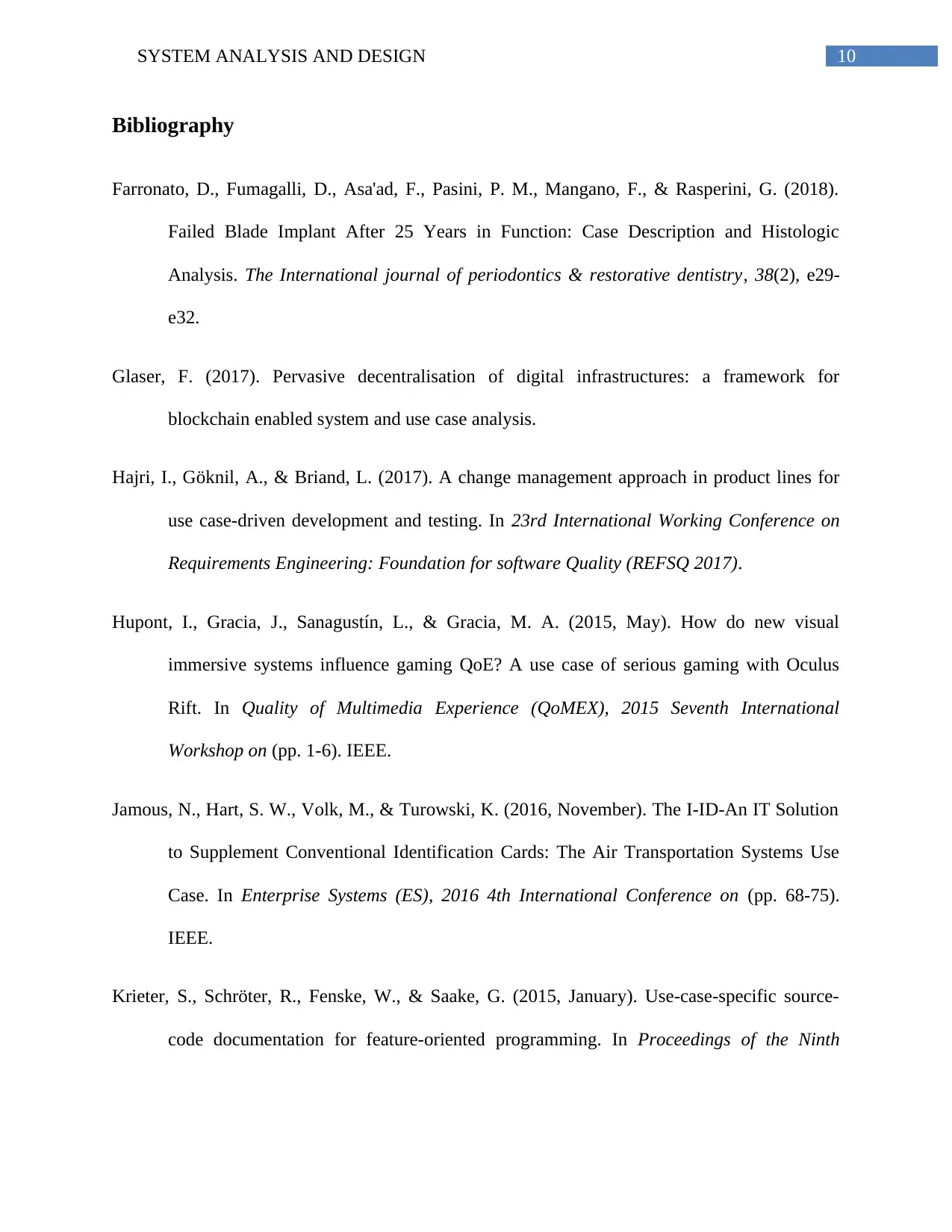
10SYSTEM ANALYSIS AND DESIGN
Bibliography
Farronato, D., Fumagalli, D., Asa'ad, F., Pasini, P. M., Mangano, F., & Rasperini, G. (2018).
Failed Blade Implant After 25 Years in Function: Case Description and Histologic
Analysis. The International journal of periodontics & restorative dentistry, 38(2), e29-
e32.
Glaser, F. (2017). Pervasive decentralisation of digital infrastructures: a framework for
blockchain enabled system and use case analysis.
Hajri, I., Göknil, A., & Briand, L. (2017). A change management approach in product lines for
use case-driven development and testing. In 23rd International Working Conference on
Requirements Engineering: Foundation for software Quality (REFSQ 2017).
Hupont, I., Gracia, J., Sanagustín, L., & Gracia, M. A. (2015, May). How do new visual
immersive systems influence gaming QoE? A use case of serious gaming with Oculus
Rift. In Quality of Multimedia Experience (QoMEX), 2015 Seventh International
Workshop on (pp. 1-6). IEEE.
Jamous, N., Hart, S. W., Volk, M., & Turowski, K. (2016, November). The I-ID-An IT Solution
to Supplement Conventional Identification Cards: The Air Transportation Systems Use
Case. In Enterprise Systems (ES), 2016 4th International Conference on (pp. 68-75).
IEEE.
Krieter, S., Schröter, R., Fenske, W., & Saake, G. (2015, January). Use-case-specific source-
code documentation for feature-oriented programming. In Proceedings of the Ninth
Bibliography
Farronato, D., Fumagalli, D., Asa'ad, F., Pasini, P. M., Mangano, F., & Rasperini, G. (2018).
Failed Blade Implant After 25 Years in Function: Case Description and Histologic
Analysis. The International journal of periodontics & restorative dentistry, 38(2), e29-
e32.
Glaser, F. (2017). Pervasive decentralisation of digital infrastructures: a framework for
blockchain enabled system and use case analysis.
Hajri, I., Göknil, A., & Briand, L. (2017). A change management approach in product lines for
use case-driven development and testing. In 23rd International Working Conference on
Requirements Engineering: Foundation for software Quality (REFSQ 2017).
Hupont, I., Gracia, J., Sanagustín, L., & Gracia, M. A. (2015, May). How do new visual
immersive systems influence gaming QoE? A use case of serious gaming with Oculus
Rift. In Quality of Multimedia Experience (QoMEX), 2015 Seventh International
Workshop on (pp. 1-6). IEEE.
Jamous, N., Hart, S. W., Volk, M., & Turowski, K. (2016, November). The I-ID-An IT Solution
to Supplement Conventional Identification Cards: The Air Transportation Systems Use
Case. In Enterprise Systems (ES), 2016 4th International Conference on (pp. 68-75).
IEEE.
Krieter, S., Schröter, R., Fenske, W., & Saake, G. (2015, January). Use-case-specific source-
code documentation for feature-oriented programming. In Proceedings of the Ninth
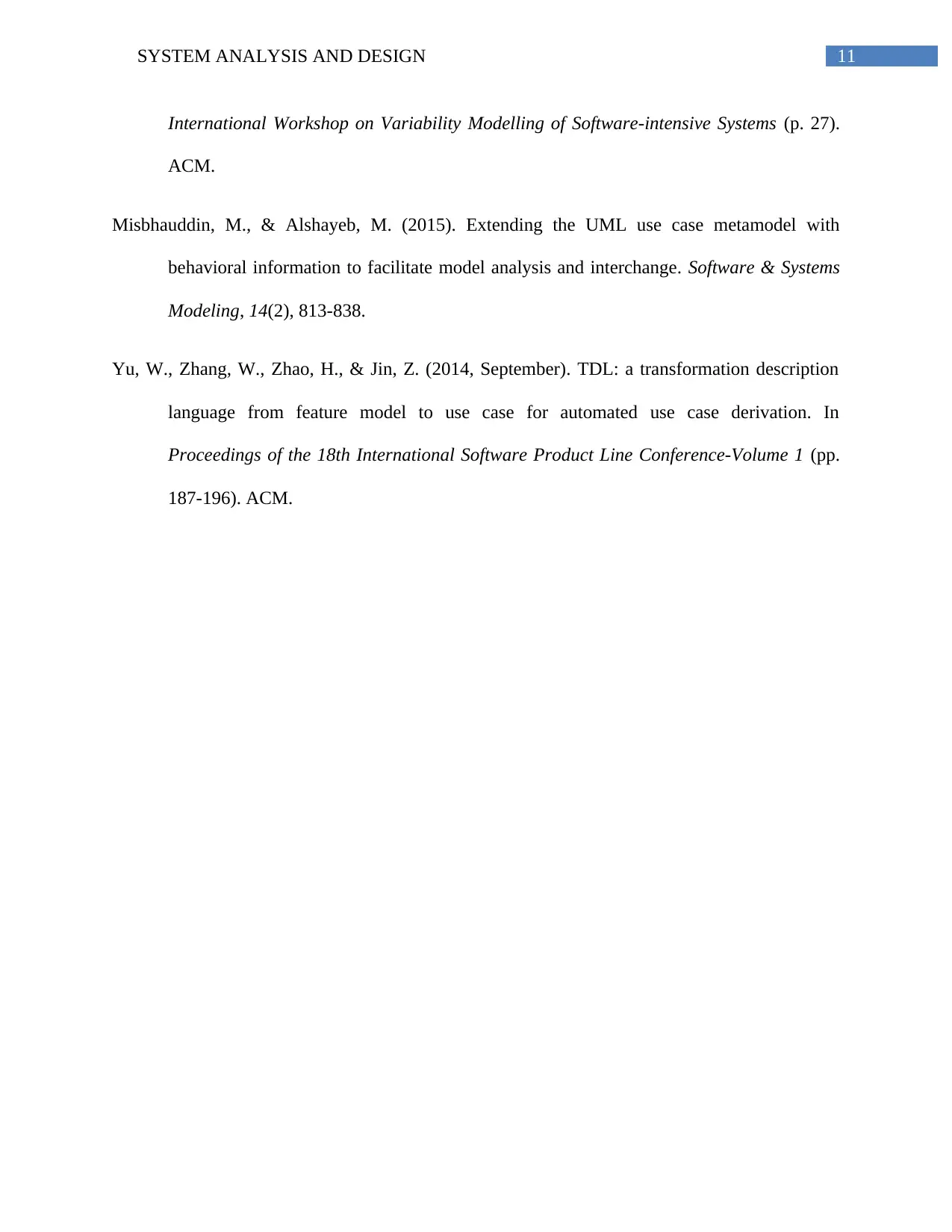
11SYSTEM ANALYSIS AND DESIGN
International Workshop on Variability Modelling of Software-intensive Systems (p. 27).
ACM.
Misbhauddin, M., & Alshayeb, M. (2015). Extending the UML use case metamodel with
behavioral information to facilitate model analysis and interchange. Software & Systems
Modeling, 14(2), 813-838.
Yu, W., Zhang, W., Zhao, H., & Jin, Z. (2014, September). TDL: a transformation description
language from feature model to use case for automated use case derivation. In
Proceedings of the 18th International Software Product Line Conference-Volume 1 (pp.
187-196). ACM.
International Workshop on Variability Modelling of Software-intensive Systems (p. 27).
ACM.
Misbhauddin, M., & Alshayeb, M. (2015). Extending the UML use case metamodel with
behavioral information to facilitate model analysis and interchange. Software & Systems
Modeling, 14(2), 813-838.
Yu, W., Zhang, W., Zhao, H., & Jin, Z. (2014, September). TDL: a transformation description
language from feature model to use case for automated use case derivation. In
Proceedings of the 18th International Software Product Line Conference-Volume 1 (pp.
187-196). ACM.
⊘ This is a preview!⊘
Do you want full access?
Subscribe today to unlock all pages.

Trusted by 1+ million students worldwide
1 out of 12
Related Documents
Your All-in-One AI-Powered Toolkit for Academic Success.
+13062052269
info@desklib.com
Available 24*7 on WhatsApp / Email
![[object Object]](/_next/static/media/star-bottom.7253800d.svg)
Unlock your academic potential
Copyright © 2020–2025 A2Z Services. All Rights Reserved. Developed and managed by ZUCOL.




